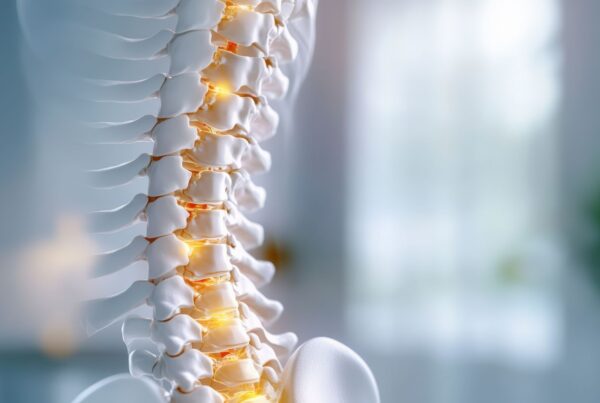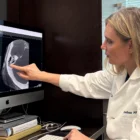Warning Signs You Shouldn’t Ignore
Cervical stenosis refers to the narrowing of the spinal canal in your neck area, which can put pressure on the spinal cord and nerve roots. This condition often develops gradually due to age-related changes or degenerative conditions affecting the spine.
When the compression of the spinal cord causes symptoms, the syndrome is known as cervical spondylotic myelopathy. Many of our patients initially come to us with mild symptoms that they’ve been managing for months or even years. While conservative treatments can help manage mild to moderate cases, there are situations when this condition can escalate into a surgical emergency requiring immediate attention. We’ve created this guide to help you understand when to seek urgent care.
When Cervical Stenosis Becomes an Emergency
When cervical stenosis progresses to the point where the spinal cord compression causes progressive symptoms, it can quickly become a surgical emergency. If cervical myelopathy is getting worse over time, it can lead to serious damage to the spinal cord if not addressed promptly.
In our years of treating spine conditions, we’ve found that several factors are associated with an emergent situation:
- Sudden, severe compression of the spinal cord
- Rapid progression of neurological symptoms
- Trauma to an already narrowed spinal canal
- Development of spinal instability
Understanding when to seek emergency care for cervical stenosis can be life-changing. We’ve seen patients who luckily consult in the nick of time to prevent permanent damage, and others who waited too long and faced more challenging recoveries. Early intervention can make all the difference.
Critical Warning Signs
We’ve seen patients who waited too long to seek care because they weren’t sure that their symptoms were not severe enough or not related to their neck. It’s important to remember that neck pain is not always associated with compression of the spinal cord. When it comes to cervical stenosis, certain symptoms should never be ignored, as they indicate a true emergency requiring immediate medical attention:
Difficulty with Hand Coordination
Rapid loss of hand coordination or weakness can be an early sign of progressive cervical spinal cord damage. Although this may be related to issues in the wrist, such as Carpal Tunnel Syndrome, if the entire hand is weak or tingling, it is more likely related to the cervical spine.
Sudden Weakness or Paralysis
A surgical emergency exists when cervical stenosis causes sudden weakness or paralysis in the arms, legs, or both. This symptom indicates significant spinal cord compression that can lead to permanent disability if not addressed promptly.
Loss of Bladder or Bowel Control
The sudden inability to control bladder or bowel function is a serious red flag that should never be ignored. This symptom, if related to the spine, represents a true spinal emergency that requires immediate surgical intervention.
Severe Neck Pain with Neurological Symptoms
While neck pain alone is rarely an emergency, severe neck pain accompanied by neurological symptoms such as numbness, tingling, or weakness in the extremities may indicate critical spinal cord compression requiring urgent evaluation.
Difficulty Walking or Balance Problems
Sudden or rapidly worsening difficulty with walking, coordination, or balance can signal spinal cord dysfunction from severe cervical stenosis and should prompt immediate medical evaluation.
It's time to get back
to doing what you love.
Progressive Symptoms That Require Urgent Attention
Beyond the critical warning signs above, certain progressive symptoms may not constitute an immediate emergency but do warrant urgent medical attention, typically within weeks:
- Increasing numbness or tingling in arms or legs
- Progressive weakness in limbs over weeks to a month
- Worsening difficulty with fine motor skills (like buttoning clothes or writing)
- Increasing problems with balance or coordination
- Symptoms that significantly worsen with certain neck positions
These progressive symptoms suggest that cervical stenosis is actively compromising neurological function and could potentially develop into a full emergency if left unaddressed.
The key with all of these symptoms is the rate or speed with which the symptoms worsen.
Diagnosis of Emergency Cervical Stenosis
When emergency symptoms of cervical stenosis present, rapid diagnosis is crucial. Diagnostic procedures typically include:
- Detailed neurological examination to assess strength, sensation, and reflexes
- MRI scanning, which provides the most detailed images of the spinal cord
- X-rays to evaluate spinal alignment and stability, especially after trauma
- CT scan in cases where MRI is contraindicated
The goal of emergent diagnosis is to quickly determine the location and severity of spinal cord compression to guide immediate treatment decisions.
Treatment Options for Emergency Situations
When cervical stenosis becomes an emergency, surgical intervention is usually necessary to relieve pressure on the spinal cord and prevent permanent damage. We’ve found that patients occasionally worry about spine surgery, but in emergency situations, the benefits far outweigh the risks.
Timing is crucial in these cases—studies consistently show that outcomes are significantly better when surgery is performed as soon as possible following the onset of severe symptoms. This is why recognizing the warning signs early is so important.
Several surgical approaches might be considered, including:
- Anterior cervical discectomy and fusion (ACDF), where we access the spine from the front of the neck
- Cervical laminectomy and fusion, where we remove part of the vertebral bone to create more space and stabilize the spine with implants and bone graft.
- Cervical laminoplasty, where bones of the spine are repositioned (but not removed) to create more space.
The approach we recommend depends on several factors: where exactly the compression is located, how extensive it is, the shape of your cervical spine, and your overall health. Many of our patients are surprised by how quickly they begin to feel relief after surgery for severe symptoms.
Prevention and Management
While not all cases of cervical stenosis can be prevented from becoming emergencies, certain strategies may reduce risk:
- Following through with recommended treatments for known cervical stenosis
- Avoiding activities that could cause neck trauma
- Recognizing and reporting early neurological symptoms before they progress
- Regular follow-up with spine specialists for patients with known stenosis
- Physical therapy to maintain neck strength and flexibility
These preventive measures are particularly important for individuals already diagnosed with cervical stenosis who wish to avoid emergency situations.
When to Seek Immediate Medical Care
We often tell patients that when it comes to potential spinal cord compression, it’s always better to err on the side of caution. If you experience any of these symptoms, don’t wait, seek emergency medical care immediately:
- Sudden weakness or numbness in your arms or legs
- Inability to control your bladder or bowel function
- Severe neck pain with numbness, tingling, or weakness
- Sudden problems with walking or balance
- Progressive worsening of existing symptoms over days to weeks
We’ve had patients tell us they didn’t want to “bother” anyone or thought they should just “tough it out.” But with spinal emergencies, waiting can mean the difference between a full recovery and permanent disability. Emergency physicians can quickly determine whether your symptoms represent a true spinal emergency requiring immediate intervention.
FAQs
How quickly can cervical stenosis become an emergency?
While cervical stenosis typically develops gradually over years, the transition from manageable symptoms to emergency can happen surprisingly fast, sometimes within days. This can occur with increased compression on the spinal cord, from minor trauma or a herniated disc, but can also take place without any inciting event.
Can physical therapy help prevent cervical stenosis emergencies?
Physical therapy can be valuable for managing symptoms and potentially slowing progression in mild to moderate cases. A properly designed physical therapy program strengthens neck muscles, improves posture, and increases flexibility, all of which can help maintain space around the spinal cord. However, once severe symptoms develop, particularly those indicating an emergency, physical therapy alone is insufficient and may actually be contraindicated until surgical decompression occurs.
Are there activities I should avoid if I have cervical stenosis?
If you’ve been diagnosed with cervical stenosis, it’s generally advisable to avoid high-impact activities, contact sports, and extreme neck positions that could worsen compression. Activities that involve repeated jarring of the spine (like horseback riding or off-road driving) or positions that require sustained neck extension (like certain yoga poses or ceiling painting) could potentially increase your risk of worsening symptoms or even triggering an emergency situation.
How can I tell the difference between regular neck pain and a cervical stenosis emergency?
Regular neck pain typically stays localized to the neck area, may be affected by movement or position, and isn’t associated with neurological symptoms. Warning signs that indicate a possible emergency include: pain that radiates down your arms, numbness or weakness in your limbs, problems with balance or coordination, or any issues with bladder or bowel control. The key differentiator is the presence of neurological symptoms, if your neck pain is accompanied by any of these, seek immediate medical attention.
After emergent surgery for cervical stenosis, what kind of recovery can I expect?
Recovery after emergent surgery varies widely depending on how severe the spinal cord compression was and how long it was present before surgery. Many patients experience improvement in their symptoms shortly after surgery, particularly sensory changes. Motor function (strength and coordination) may take longer to recover, typically weeks to months. Complete recovery is more likely when surgical decompression occurs quickly after symptoms begin, which is why recognizing emergency signs early is so crucial.
Can cervical stenosis emergencies recur after treatment?
Yes, even after successful treatment, there is a possibility that emergency symptoms could recur, particularly if the underlying stenosis wasn’t fully addressed or if it develops at other levels of the spine. This is one reason why follow-up care is so important. After emergency treatment, your surgeon will likely recommend a long-term management plan that may include regular monitoring, physical therapy, and lifestyle modifications to reduce the risk of future emergencies.

About Ridgewood
Our team of board certified physicians, located in Ridgewood, New Jersey, are dedicated to bringing you the latest developments and treatment options for spinal surgery. We strive to produce the most clarified & clear content to help you make informed decisions on your medical journey. The road to feeling like your true self should not feel lonely- Let us help you. Please call us to schedule a consultation and speak to one of our team members.






